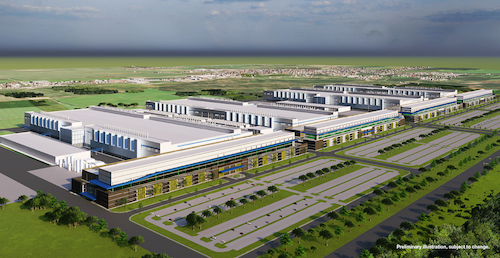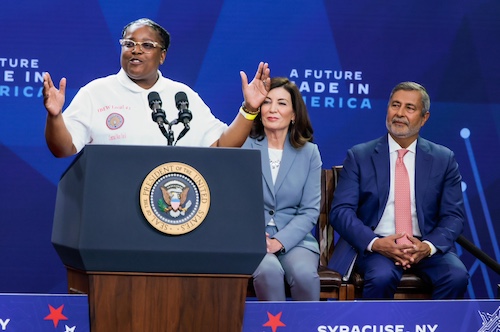For two years, Syracuse, N.Y., Local 43 Business Manager Alan Marzullo was part of a small group working with state and civic leaders to convince Micron Technology to build a new semiconductor facility in their community.

|
| An architect’s rendering of the Micron Technologies facility In Clay, N.Y., when finished.
|
Plenty was at stake. Micron officials were considering making the largest private investment in New York state history, especially if legislation in Congress to support the microchip industry was passed and signed into law.
"I'm not going to lie," he said with a laugh. "There were a lot of sleepless nights."
It paid off. Micron, a leading computer chip maker based in Boise, Idaho, announced Oct. 3 that it will build a $100 billion facility in Clay, N.Y., about 15 miles north of Syracuse, over the next 20 years. Work is expected to begin in either late 2023 or early 2024.
The facility will be entirely union-built and employ about 9,000 construction workers. About one-third will be IBEW members, who will handle all the electrical work. It follows up an announcement a few weeks earlier by Intel to build a $20 billion semiconductor facility in New Albany, Ohio, where electrical work during construction is expected to be done by members of Newark, Ohio, Local 1105.
Marzullo and other members of the Central-Northern New York Building & Construction Trades Council had to show why the massive facility should be built with high-quality union labor. On top of that, everyone involved was sworn to secrecy. An ill-timed leak could have quashed the project. There was little Marzullo could tell his staff and closest confidants.
Signing any project labor agreement is a moment to cherish for any business manager or IBEW official. But the size and scope of this one is nearly unprecedented. That wasn't lost on Marzullo.
"I remember getting back to my office, shutting the door, and sitting back and going, 'My goodness,'" he said. "It was very emotional. We changed the lives of not just of all my members, but everyone living in this community."
International President Lonnie R. Stephenson thanked Marzullo and everyone involved in bringing the facility to the area and ensuring that the IBEW is part of it.
"The importance of this can't be overstated," Stephenson said. "A facility vital to this country's national interests will be built entirely with highly skilled union labor.
"This is a great moment not just for Local 43 and the Syracuse community but for all IBEW members. This has the potential to touch so many of our local construction unions throughout North America."
The deal is significant on multiple levels.
First, Micron officials said they would not have committed to such a massive facility without the CHIPS and Science Act, which was passed by Congress and signed into law by President Joe Biden in July.

|
| Syracuse Local 43 member Shawni Davis introduces President Biden during an Oct. 27 ceremony with New York Gov. Kathy Hochul and Micron Technologies CEO Sanjay Mehrotra in the background.
|
The bill contains $52 billion in incentives to encourage companies to produce important semiconductors in the United States, which will strengthen national security and lessen dependence on foreign product supply chains.
Such investments are common in many countries, including in China, which has used them to become a force in the computer-chip industry. Many leading economists say supply chain breakdowns have played a large role in inflation problems, not just in the U.S. but internationally.
"There is no doubt that without the CHIPS Act, we would not be here today," Micron CEO Sanjay Mehrotra said while making the announcement.
Biden visited Syracuse on Oct. 27, meeting with Mehrotra and other officials from the company and local government. Local 43 member Shawni Davis introduced him before his public address.
The IBEW, which has worked closely with the Biden administration on several initiatives, lobbied with its allies to get the measure passed on a bipartisan vote. The final Senate vote was 64-32, with 15 GOP members voting for it. It passed 243-187 in the House.
"On a project of this size, there is no doubt the relationship that President Stephenson and others at the International Office have with the administration helped us," Marzullo said.
Second, it showed the power of building relationships with leading political figures on a bipartisan basis.
Marzullo and other building trades leaders worked closely with New York Gov. Kathy Hochul and Sen. Chuck Schumer, both Democrats. The state put together $5.5 billion in incentives for Micron. Schumer, the Senate majority leader, was the author of the CHIPS Act and led the effort on the Senate floor to get it passed.
They also worked closely with Syracuse Mayor Ben Walsh, an independent, and Rep. John Katko and Onondaga County Executive Ryan McMahon, both Republicans. Katko, considered one of the less partisan members of the House, is retiring at the end of the current congressional session.
Marzullo said Local 43 has enjoyed a productive relationship with all three men. That helped ensure that the IBEW and other unions were treated fairly.
"I can honestly tell you those political relationships matter," he said. "When the politicians trust you and respect your honesty and your vision and your integrity, they will bring you into the process, and that is really what unfolded here. They entrusted the IBEW to give accurate information on how to build this project."
And finally, Micron's decision dispelled a false notion presented by anti-union voices that companies are reluctant to build in a state with a strong labor presence.
Company officials chose the Syracuse area over a proposal from Lockhart, Texas, near Austin. Texas is a right-to-work state, and officials there often work against organized labor. Micron earlier also turned down a proposed site in North Carolina, another right-to-work state with low union density.
"Like any company, Micron was concerned about labor costs, and Governor Hochul asked all of us: 'Are there ways you can talk to them about that?'" Marzullo said. "Our answer was, 'Yes, there are, and you do that with a project labor agreement.'"
The PLA also includes benchmarks for hiring traditionally underrepresented workers, such as women and people of color, Marzullo said. Veterans are another group that will be targeted. That helps ensure that the entire community benefits from the plant's construction, he said.
"We want to make sure everyone in our community has a chance at a good-paying union job," Marzullo said. "There's no better path to make that happen."
Micron's decision will present some challenges.
Like nearly the entire U.S., upstate New York has a shortage of skilled construction workers. Even before the announcement, Local 43 doubled the size of its training center, Marzullo said. Attempts to organize nonunion electricians and contractors will only intensify. The opportunity for steady work on such a massive project will be a tempting carrot.
Marzullo noted that Local 43 and its signatories still will be responsible for other, ongoing construction work. Going forward, one of his priorities is to make sure those projects are fully staffed even as work on the Micron plant ramps up.
"We've never had a problem at Local 43 in getting applicants," Marzullo said. "It's not so much getting apprentices. It's getting them to journeyman status quicker."
Micron's decision likely will have an impact on IBEW members throughout the northeast and even North America. Travelers almost certainly will be needed.
Schumer called Micron's decision an "Erie Canal moment," a reference to the construction of the canal in the early part of the 19th century that connected the Hudson River in the east to Lake Erie in western New York. It is often called "the nation's first superhighway," and it led to the ascendancy of New York as the nation's economic center.
"This investment leaves no question that the future of microchip manufacturing will remain not just in this country, but in Syracuse specifically, and that our future will be built in upstate New York," Schumer said.
Third District Business Development Representative Ed Hill Jr. noted that the CHIPS Act was already playing a role in attracting union employers even before the Micron agreement.
IBM announced plans for a $20 million investment in New York's Hudson Valley during the next 10 years. GlobalFoundries has announced plans for a $6 billion to $8 billion expansion of its computer chip factory in Malta, N.Y., near the state capital of Albany.
"It's just having an amazing effect in a very quick time frame with all the projects that have been announced," Hill said. "It's really high-quality work for our members.
"I've never seen anything turn around so quickly. Usually, when you have programs with incentives and tax breaks, it takes quite a while to see results like this."
In and around Syracuse, it's led to one that is going to pay off for Local 43 and the entire community for many years to come.
"What's good for the country almost always is good for skilled union construction," Stephenson said. "It's why we worked so hard to get the CHIPS Act passed into law. It's a reminder of why we worked to get President Biden elected. Many thanks to him, Senator Schumer, Governor Hochul and everyone who worked to make this a reality."
Third District International Vice President Dennis Affinati said he "couldn't be happier for everyone at Local 43."
"I know it takes a herculean effort to secure a project of this historic size and scope," he added. "Congratulations to Business Manager Marzullo and everyone who helped take this over the finish line."